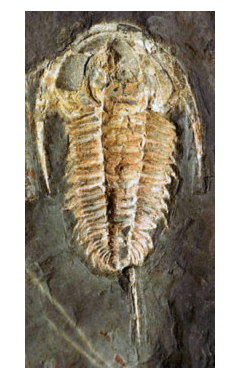Redlichiida
| Redlichiida Temporal range: Early – Middle Cambrian, 525–500Ma | |
|---|---|
 | |
| Redlichia takooensis , a member of the trilobite order Redlichiida. Lower Cambrian Emu Shale Kangaroo Island, South Australia (© Dave Simpson) | |
| Scientific classification | |
| Kingdom: | Animalia |
| Phylum: | Arthropoda |
| Class: | Trilobita |
| Order: | Redlichiida Richter, 1932 |
| Suborders | |
Redlichiida is an order within the major extinct arthropod class Trilobita.[1] The Redlichids are one of the four older taxa of trilobites that originated in the Lower Cambrian.
Redlichid trilobites are the first arthropods to appear in the fossil record. The earliest known trilobite seems to be the genus Fallotaspis, which is a Redlichid. They are common fossils in Lower Cambrian faunas worldwide. They died out before the end of the Middle Cambrian. The two major Lagerstätten, at which Redlichids are found, are the Emu Bay shales of Southern Australia and the Maotianshan shales near Chengjiang in China.
Physical description
(See the Trilobite article for a definition of morphological terms)
Redlichids look primitive in comparison with later and (by the Middle Cambrian) contemporary trilobites. They typically have a large, semicircular cephalon and a highly-segmented thorax that tapers back to a small pygidium. Unlike many other trilobite orders, the Redlichids were probably not capable of defensive enrollment. The Redlichids generally have prominent, long, crescent-shaped eyes. They are often quite spiny with some or all of the following: genal, glabular, tail, segment spines. One Redlichid family, the Olenellids, typically have long spines on the third thoracic segment. [2]
The appendages have been preserved in a few specimens. They follow typical trilobite patterns in terms of the number, placement, and types of legs, antennae, gills, etc.
Suborders
The Redlichiids are divided into two suborders: Olenellina and Redlichiina.
The Olenellids are found in North America and associated areas that comprised the Cambrian continent of Laurentia. They are very common and are used to define the scope of Laurentia. Their abrupt disappearance marks the Lower-Middle Cambrian boundary in areas where the Olenellids are found. Olenellids do not have a facial suture.
Members of suborder Redlichiina are associated with Cambrian regions other than Laurentia. They have facial sutures and their remains are frequently found without their librigena, or "free cheeks". The relatively uncommon Bathynotids had facial sutures, long genal spines, and long spines on the final thoracic segment.
References
- ↑ Redlichiida at Paleobiology Database. Accessed 2010-01-01.
- ↑ S. M. Gon III. "Order Redlichiida". Retrieved December 4, 2011.